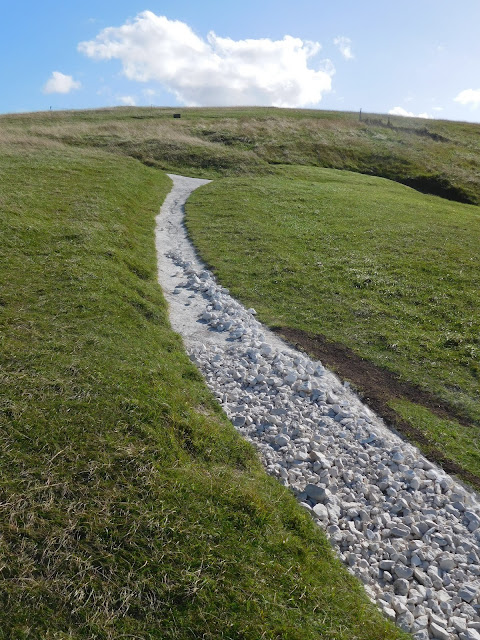On Thursday it was sunny and even though we'd been shopping and I was tired - we went out. The chance was too good to miss.
I may have regretted it when I realised how far it was and when we got there we found the council had closed the road we needed for road works. I was a bit shattered by the time we actually arrived.
It was worth it though;
This is 'The Uffington White Horse', which gave it's name to 'The Vale of the White Horse' which is the area around it.
Here's the view from nearer;
But it's only from the air that you can actually see the full glory of the White Horse (this is from The National Trust's website);
The horse was cut out of the chalk about 3000 years ago in the late bronze age.
And while there are many White Horses, this one has been dated by a new technique which can measure when soil was last disturbed - so it's the real thing. It's from 800 to 1200 B.C.
There is, of course, a lot of mystery attached to something so ancient - this extract is from wiltshirewhitehorses.org.uk
The original purpose of this horse is unknown. It may have been the emblem of a local tribe, and have been cut as a totem or badge marking their land, or it may have had a religious purpose or significance. The horse-goddess Epona was worshipped by the Celts in Gaul, and she had a counterpart in Britain, Rhiannon, so the Uffington white horse may have been cut by adherents of a cult of the horse-goddess.
Alternatively, the horse could have been cut by worshippers of the sun god Belinos or Belenus, who was associated with horses. He was sometimes depicted on horseback, and Bronze and Iron Age sun chariots were shown as being drawn by horses. Conceivably, if this suggestion is correct, the horse could have been cut on the shallower slope at the top of the hill in order to be seen from above by the god himself.
But to understand the horse you need to take a closer look at the ancient landscape all around because nothing is as natural as it looks.
This is the view over the Vale from the horse itself;
Clearly, there's a commanding view over the whole area.
On the left there are a series of ridges, which could be caused by erosion but to me are definitely man-made;
While on the right is a definite platform which is not a farm track carved out by a tractor;
While over on the far left is 'Dragon Hill', which was once a glacier cut hill but was then shaped by man to make a platform.
I can't help thinking that the purpose of the horse was to show all the other tribes around who was boss - possession of horses was crucial both for farming and for war.
This is saying "F*** off or die - we have horses".
Dragon hill looks to me as though it was viewing platform or the site of sacrifices while the carved valley seems to be a ceremonial entrance to the site.
And everything was done by hand with primitive tools.
Either way, the real power of the site is that if it were just left alone, the image would have been lost in just a few years.
Even though the people of the white horse must have died out before even the Romans arrived, local people held a festival every year to refill the trenches with chalk to preserve the image........for two millennia.
It still goes on as you can see;
At the top of the hill we found the 'Trig Point';
If you've ever climbed a mountain in the mist or snow or got lost, these pillars are a life saver. Left by The Ordnance Survey mapmakers they mark the highest point and the three grooves point to the next nearest three highest points.
So, you can find where you are and work out where you are going. All of which may be redundant in these sat-nav days but it's always a good feeling to find a trig point.
This may be my last one.
The Trig point is by the side of the ditch and wall of 'Uffington Castle', which is an Iron Age Hill Fort next to the White Horse Complex.
Even today it's big;
Remember 2500 years of erosion has lowered the wall and filled the ditch.
This is how tall it is today;
Hmmmmmh;
And then, just like the day before, we got buzzed by a Chinnook;
Who are they planning to invade now?
Neil Harris
(a don't stop till you drop production)
Home: helpmesortoutstpeters.blogspot.com
Contact me: neilwithpromisestokeep@gmail.com













No comments:
Post a Comment